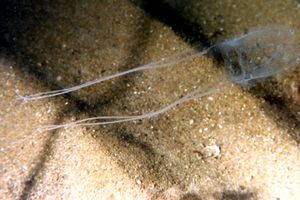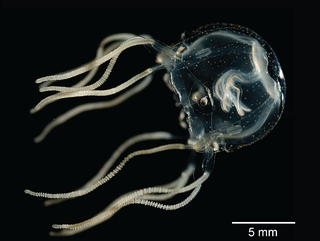
Jellyfish and sea jellies are the informal common names given to the medusa-phase of certain gelatinous members of the subphylum Medusozoa, a major part of the phylum Cnidaria. Jellyfish are mainly free-swimming marine animals with umbrella-shaped bells and trailing tentacles, although a few are anchored to the seabed by stalks rather than being mobile. The bell can pulsate to provide propulsion for highly efficient locomotion. The tentacles are armed with stinging cells and may be used to capture prey and defend against predators. Jellyfish have a complex life cycle; the medusa is normally the sexual phase, which produces planula larva that disperse widely and enter a sedentary polyp phase before reaching sexual maturity.

Box jellyfish are cnidarian invertebrates distinguished by their box-like body. Some species of box jellyfish produce potent venom delivered by contact with their tentacles. Stings from some species, including Chironex fleckeri, Carukia barnesi, Malo kingi, and a few others, are extremely painful and often fatal to humans.

Aurelia aurita is a widely studied species of the genus Aurelia. All species in the genus are very similar, and it is difficult to identify Aurelia medusae without genetic sampling; most of what follows applies equally to all species of the genus. The most common method used to identify the species consists of selecting a jellyfish from a harbour using a device, usually a drinking glass and then photographing the subject. This means that they can be released in to the harbour shortly afterwards and return to their natural habitat.

Chironex fleckeri, commonly known as the Australian box jelly, and nicknamed the sea wasp, is a species of extremely venomous box jellyfish found in coastal waters from northern Australia and New Guinea to Malaysia, the Philippines and Vietnam. It has been described as "the most lethal jellyfish in the world", with at least 64 known deaths in Australia from 1884 to 2021.

Chironex is a genus of box jellyfish in the family Chirodropidae. Their stings are highly venomous, and have caused human fatalities. Based on present knowledge, the genus is restricted to the central Indo-Pacific, ranging from southern Japan to northern Australia.

Medusozoa is a clade in the phylum Cnidaria, and is often considered a subphylum. It includes the classes Hydrozoa, Scyphozoa, Staurozoa and Cubozoa, and possibly the parasitic Polypodiozoa. Medusozoans are distinguished by having a medusa stage in their often complex life cycle, a medusa typically being an umbrella-shaped body with stinging tentacles around the edge. With the exception of some Hydrozoa, all are called jellyfish in their free-swimming medusa phase.

Carybdea is a genus of venomous box jellyfish within the family Carybdeidae that currently consists of a total of 8 species. This genus of jellyfish are often found in warm waters around the world in waters such as the Mediterranean Sea, the Pacific Ocean, and off the coast of Africa. Their sting can cause a range of effects depending on the species. These invertebrates will go through both sexual and asexual reproduction as they transform from a polyp to medusa. Carybdea have a box-shaped bell with four tentacles and eye-like sensory structures. There are distinct physical markings that differentiate many species within the genus. While Carybdea use their venom to act as predators, they are also preyed on by turtles and various fish. They feed on plankton, invertebrates, fish, and some crustaceans.

Chirodropidae is a family of venomous box jellyfish within the class Cubozoa.

Turritopsis dohrnii, also known as the immortal jellyfish, is a species of small, biologically immortal jellyfish found worldwide in temperate to tropic waters. It is one of the few known cases of animals capable of reverting completely to a sexually immature, colonial stage after having reached sexual maturity as a solitary individual. Others include the jellyfish Laodicea undulata and species of the genus Aurelia.

Alatina alata(Reynaud, 1830), often called a sea wasp, is a species of box jellyfish found in the Pacific, Indian and Atlantic Oceans and in the Caribbean and Arabian Sea.

Carybdeida is an order of box jellyfish. There are five families within the order. They are distinguished from other box jellyfish by the presence of unbranched muscular bases at the corners of the cubic umbrella. Most species have four tentacles.

Carybdea branchi, the South African box jellyfish, is a venomous species of cnidarian, in the small family Carybdeidae within the class Cubozoa.

Copula is a monotypic genus of box jellyfish in the family Tripedaliidae of the phylum Cnidaria. The only species in the genus is Copula sivickisi, a very small gelatinous, bell-shaped organism with four tentacles that is active only at night. It is unusual among box jellyfish in having a mating ritual and internal fertilisation. The specific name honours the Lithuanian zoologist Pranciškus Baltrus Šivickis.

Carybdea marsupialis, is a venomous species of cnidarian, in the small family Carybdeidae within the class Cubozoa.
Malo filipina is a small and venomous Irukandji jellyfish found in the Philippines. It was first described to science in 2012, and is one of four species in genus Malo, often confused in the past with the M. maximus.

Alatina is a genus of box jellyfish within class Cubozoa. It is the largest of the three known genera in the family Alatinidae, and the only one which is not monotypic. It contains the following ten species:

Chironex yamaguchii, commonly known as habu-kurage in Japanese and as "hub jellyfish" due to erroneous machine translations, is a species of box jellyfish found in coastal waters around Japan, on Okinawa and the Ryukyu Islands, and in the Philippines. It is highly venomous.

Chiropsoides is a genus of box jellyfish in the family Chiropsalmidae. It is monotypic, with a single species, Chiropsoides buitendijki. The most distinct species characteristics are the shape of the gastric saccules, the pedalial canals, and the unilateral pedalial branching.

Morbakka virulenta is a species of box jellyfish that is found in waters near the islands of Japan. The species was originally described in the genus Tamoya by Kamakichi Kishinouye in 1910. However, unlike other species of that genus, this jellyfish did not have the vertical gastric phacellae which protect the inside of the bell with nematocyst warts. As a result, it was reclassified to the genus Morbakka due to its distinctively shaped rhopaliar horns which resemble rabbit ears. Because of its painful stings, M. virulenta has been nicknamed Hikurage, which is “fire jellyfish” in Japanese.
Chiropsella bronzie is a species of box jellyfish. It is considered much less of a threat to humans than some of its relatives. The species was described in 2006, and is one of four species in the genus Chiropsella. Chiropsella bronzie can be found in shallow waters off the coast of Queensland, Australia.















